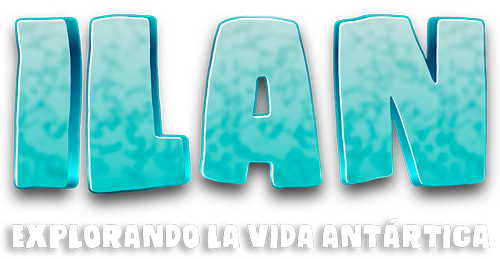Referencias
La mayoría de la información científica para definir las especies y sus interacciones ecológicas fueron obtenidas de las siguientes fuentes generales y las publicaciones citadas dentro de ellas:
- Schories, D., & Kohlberg, G. (Eds.). (2016). Marine Wildlife, King George Island, Antarctica. Dirk Schories Publications. (https://www.researchgate.net/publication/320556670_Marine_Wildlife_King_George_Island_Antarctica)
- Instituto Antártico Chileno (2019). "Especies de la Antártica Chilena”.
- Fukuchi, M., & Marchant, H. J. (2006). Antarctic Fishes. Rosenberg Pub Pty Limited. https://books.google.nl/books?hl=es&lr=&id=zO23IXjiOtAC&oi=fnd&pg=PA6&dq=Fukuchi,+M.,+%26+Marchant,+H.+J.+(2006).+Antarctic+Fishes.+Rosenberg+Pub+Pty+Limited.&ots=CC0Gi3DO5I&sig=-8nYDqUGyh68GyaSRwaYZx3MHyY#v=onepage&q&f=false
- Los nombres científicos actualizados fueron verificados en la base de datos: https://www.marinespecies.org/
Otras fuentes consultadas
- Arnould, J. P., & Whitehead, M. D. (1991). The diet of Antarctic petrels, cape petrels and southern fulmars rearing chicks in Prydz Bay. Antarctic Science, 3(1), 19-27. https://doi.org/10.1017/S0954102091000056
- Banks, J., Lea, M. A., Wall, S., McMahon, C. R., & Hindell, M. A. (2014). Combining bio-logging and fatty acid signature analysis indicates spatio-temporal variation in the diet of the southern elephant seal, Mirounga leonina. Journal of experimental marine biology and ecology, 450, 79-90. https://doi.org/10.1016/j.jembe.2013.10.024
- Barrera-Oro, E. (2002). The role of fish in the Antarctic marine food web: differences between inshore and offshore waters in the southern Scotia Arc and west Antarctic Peninsula. Antarctic Science, 14(4), 293-309. https://doi.org/10.1017/S0954102002000111
- Bradshaw, C. J., Hindell, M. A., Best, N. J., Phillips, K. L., Wilson, G., & Nichols, P. D. (2003). You are what you eat: describing the foraging ecology of southern elephant seals (Mirounga leonina) using blubber fatty acids. Proceedings of the Royal Society of London. Series B: Biological Sciences, 270(1521), 1283-1292. https://doi.org/10.1098/rspb.2003.2371
- Brault, E. K., Koch, P. L., Costa, D. P., McCarthy, M. D., Hückstädt, L. A., Goetz, K. T., ... & Harkonen, T. (2019). Trophic position and foraging ecology of Ross, Weddell, and crabeater seals revealed by compound-specific isotope analysis. Marine Ecology Progress Series, 611, 1-18. https://doi.org/10.3354/meps12856
- Casaux, R., Baroni, A., & Carlini, A. (1997). The diet of the Weddell seal Leptonychotes weddelli at Harmony Point, South Shetland Islands. Polar Biology, 18(6), 371-375. https://doi.org/10.1007/s003000050202
- Casaux, R., Baroni, A., & Carlini, A. (1998). The diet of the Antarctic fur seal Arctocephalus gazella at Harmony Point, Nelson Island, South Shetland Islands. Polar Biology, 20(6), 424-428. https://doi.org/10.1007/s003000050324
- Casaux, R., Baroni, A., & Ramon, A. (2003). Diet of antarctic fur seals Arctocephalus gazella at the Danco Coast, Antarctic Peninsula. Polar Biology, 26(1), 49-54. https://doi.org/10.1007/s00300-002-0442-3
- Casaux, R., Baroni, A., & Ramon, A. (2006). The diet of the Weddell seal Leptonychotes weddellii at the Danco Coast, Antarctic Peninsula. Polar Biology, 29(4), 257-262. https://link.springer.com/article/10.1007/s00300-005-0048-7
- Casaux, R., Baroni, A., Ramón, A., Carlini, A., Bertolin, M., & DiPrinzio, C. Y. (2009). Diet of the leopard seal Hydrurga leptonyx at the Danco Coast, Antarctic Peninsula. Polar Biology, 32(2), 307-310. https://link.springer.com/article/10.1007/s00300-008-0567-0
- Fratt, D. B., & Dearborn, J. H. (1984). Feeding biology of the Antarctic brittle star Ophionotus victoriae (Echinodermata: Ophiuroidea). Polar biology, 3(3), 127-139. https://link.springer.com/article/10.1007/BF00442644
- Gallardo-Cerda, J., Levihuan, J., Lavín, P., Oses, R., Atala, C., Torres-Díaz, C., ... & Molina-Montenegro, M. A. (2018). Antarctic rhizobacteria improve salt tolerance and physiological performance of the Antarctic vascular plants. Polar Biology, 41(10), 1973-1982. https://link.springer.com/article/10.1007/s00300-018-2336-z
- Haberman, K. L., Ross, R. M., & Quetin, L. B. (2003). Diet of the Antarctic krill (Euphausia superba Dana): II. Selective grazing in mixed phytoplankton assemblages. Journal of Experimental Marine Biology and Ecology, 283(1-2), 97-113. https://doi.org/10.1016/S0022-0981(02)00467-7
- Hückstädt, L. A., Burns, J. M., Koch, P. L., McDonald, B. I., Crocker, D. E., & Costa, D. P. (2012a). Diet of a specialist in a changing environment: the crabeater seal along the western Antarctic Peninsula. Marine Ecology Progress Series, 455, 287-301. https://doi.org/10.3354/meps09601
- Kohlbach, D., Lange, B. A., Schaafsma, F. L., David, C., Vortkamp, M., Graeve, M., ... & Flores, H. (2017). Ice algae-produced carbon is critical for overwintering of Antarctic krill Euphausia superba. Frontiers in Marine Science, 4, 310. https://doi.org/10.3389/fmars.2017.00310
- Krause, D. J., Goebel, M. E., & Kurle, C. M. (2020). Leopard seal diets in a rapidly warming polar region vary by year, season, sex, and body size. BMC Ecology, 20(1), 1-15. https://bmcecol.biomedcentral.com/track/pdf/10.1186/s12898-020-00300-y.pdf
- Panasiuk, A., Wawrzynek-Borejko, J., Musiał, A., & Korczak-Abshire, M. (2020). Pygoscelis penguin diets on King George Island, South Shetland Islands, with a special focus on the krill Euphausia superba. Antarctic Science, 32(1), 21-28. https://doi.org/10.1017/S0954102019000543
- Piñones, A., Hofmann, E. E., Daly, K. L., Dinniman, M. S., & Klinck, J. M. (2013). Modeling the remote and local connectivity of Antarctic krill populations along the western Antarctic Peninsula. Marine Ecology Progress Series, 481, 69-92. https://doi.org/10.3354/meps10256
- Peck, L. S. (2018). Antarctic marine biodiversity: adaptations, environments and responses to change. Oceanography and Marine Biology. https://library.oapen.org/handle/20.500.12657/22316
- Winter, A., Henderiks, J., Beaufort, L., Rickaby, R. E., & Brown, C. W. (2014). Poleward expansion of the coccolithophore Emiliania huxleyi. Journal of Plankton Research, 36(2), 316-325. https://doi.org/10.1093/plankt/fbt110
